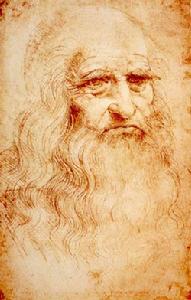博文
文艺复兴巨匠-达人芬奇
|||
Leonardo di ser Piero da Vinci ( pronunciation (help·info)) (April 15, 1452 – May 2, 1519, Old Style) was an Italian Renaissance polymath: painter, sculptor, architect, musician, scientist, mathematician, engineer, inventor, anatomist, geologist, cartographer, botanist and writer whose genius, perhaps more than that of any other figure, epitomized the Renaissance humanist ideal. Leonardo has often been described as the archetype of the Renaissance Man, a man of "unquenchable curiosity" and "feverishly inventive imagination".[1] He is widely considered to be one of the greatest painters of all time and perhaps the most diversely talented person ever to have lived.[2] According to art historian Helen Gardner, the scope and depth of his interests were without precedent and "his mind and personality seem to us superhuman, the man himself mysterious and remote".[1] Marco Rosci points out, however, that while there is much speculation about Leonardo, his vision of the world is essentially logical rather than mysterious, and that the empirical methods he employed were unusual for his time.[3]
Born out of wedlock to a notary, Piero da Vinci, and a peasant woman, Caterina, at Vinci in the region of Florence, Leonardo was educated in the studio of the renowned Florentine painter, Verrocchio. Much of his earlier working life was spent in the service of Ludovico il Moro in Milan. He later worked in Rome, Bologna and Venice, and he spent his last years in France at the home awarded him by Francis I.
Leonardo was and is renowned[2] primarily as a painter. Among his works, the Mona Lisa is the most famous and most parodied portrait and The Last Supper the most reproduced religious painting of all time, with their fame approached only by Michelangelo's The Creation of Adam.[1] Leonardo's drawing of the Vitruvian Man is also regarded as a cultural icon,[4] being reproduced on items as varied as the euro, textbooks, and T-shirts. Perhaps fifteen of his paintings survive, the small number because of his constant, and frequently disastrous, experimentation with new techniques, and his chronic procrastination.[nb 2] Nevertheless, these few works, together with his notebooks, which contain drawings, scientific diagrams, and his thoughts on the nature of painting, compose a contribution to later generations of artists only rivalled by that of his contemporary, Michelangelo.
Leonardo is revered[2] for his technological ingenuity. He conceptualised a helicopter, a tank, concentrated solar power, a calculator,[5] the double hull, and he outlined a rudimentary theory of plate tectonics. Relatively few of his designs were constructed or were even feasible during his lifetime,[nb 3] but some of his smaller inventions, such as an automated bobbin winder and a machine for testing the tensile strength of wire, entered the world of manufacturing unheralded.[nb 4] He made important discoveries in anatomy, civil engineering, optics, and hydrodynamics, but he did not publish his findings and they had no direct influence on later science.[6]

Born out of wedlock to a notary, Piero da Vinci, and a peasant woman, Caterina, at Vinci in the region of Florence, Leonardo was educated in the studio of the renowned Florentine painter, Verrocchio. Much of his earlier working life was spent in the service of Ludovico il Moro in Milan. He later worked in Rome, Bologna and Venice, and he spent his last years in France at the home awarded him by Francis I.
Leonardo was and is renowned[2] primarily as a painter. Among his works, the Mona Lisa is the most famous and most parodied portrait and The Last Supper the most reproduced religious painting of all time, with their fame approached only by Michelangelo's The Creation of Adam.[1] Leonardo's drawing of the Vitruvian Man is also regarded as a cultural icon,[4] being reproduced on items as varied as the euro, textbooks, and T-shirts. Perhaps fifteen of his paintings survive, the small number because of his constant, and frequently disastrous, experimentation with new techniques, and his chronic procrastination.[nb 2] Nevertheless, these few works, together with his notebooks, which contain drawings, scientific diagrams, and his thoughts on the nature of painting, compose a contribution to later generations of artists only rivalled by that of his contemporary, Michelangelo.
Leonardo is revered[2] for his technological ingenuity. He conceptualised a helicopter, a tank, concentrated solar power, a calculator,[5] the double hull, and he outlined a rudimentary theory of plate tectonics. Relatively few of his designs were constructed or were even feasible during his lifetime,[nb 3] but some of his smaller inventions, such as an automated bobbin winder and a machine for testing the tensile strength of wire, entered the world of manufacturing unheralded.[nb 4] He made important discoveries in anatomy, civil engineering, optics, and hydrodynamics, but he did not publish his findings and they had no direct influence on later science.[6]
列奥纳多·达·芬奇,是意大利文艺复兴三杰(达芬奇、米开朗琪罗、拉斐尔)之一,也是整个欧洲文艺复兴时期最完美的代表。他是一位思想深邃,学识渊博、多才多艺的画家、寓言家、雕塑家、发明家、哲学家、音乐家、医学家、生物学家、地理学家、建筑工程师和军事工程师。他是一位天才,他一面热心于艺术创作和理论研究,研究如何用线条与立体造型去表现形体的各种问题;另一方面他也同时研究自然科学,为了真实感人的艺术形象,他广泛地研究与绘画有关的光学、数学、地质学、生物学等多种学科。他的艺术实践和科学探索精神对后代产生了重大而深远的影响。我国科技大师钱学森先生提出的“天问”,难道达人芬奇不该是参照的对象之一吗。
https://wap.sciencenet.cn/blog-297341-543528.html
上一篇:计算药物化学的研究方法
下一篇:真正的中国文化--汉语诗律学